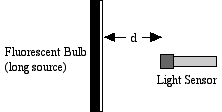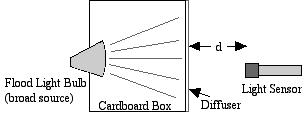How does the light intensity change as one moves away from the source? Physics classes often conduct an experiment in how light intensity changes as one moves away from a small light source. They determine, within experimental error, that the relationship is an inverse square.What would the relationship be if a long, thin light source were used instead? How would this change in geometry affect the mathematics?
What would the relationship be if a large, uniformly lighted source were used? And can these latter questions shed light (pun intended) on another important area of physics?
Before describing labs that could be done, let us note that electric field varies as one moves away from a point charge as 1/r2, inverse square. In many AP and honors classes we discuss the electric field around a charged wire. The conclusion is the field varies as 1/r, or inverse. And finally, if one has a sheet of charge, there is no change as you move away. Does light have these same patterns?
Purpose
Determine the rate of change in light intensity as one moves away from different light sources. Compare these patterns with the patterns for electric field, a very difficult area to study.
Equipment
Light Sensor, LabPro, Macintosh or PC Computer or TI graphing calculator or Palm OS device, small light source (minimag light is suggested), long fluorescent bulb (magnetic ballast required), flood light, box with light diffuser.
Procedure
Small Light Source

- Construct your lab setup so reflections from nearby
surfaces are minimized. You may consider putting a cylinder of
black paper around the Light Sensor to cut down on light coming
from sources other than the one you are studying.
- Set up data collection within Logger Pro for "Events with
Entry". You will be entering the distance values and the
computer will gather the light intensity values.
- Move in regular intervals away from the light, collecting
8-10 values at different distances
- Analyze the graph you obtain. Be ready to share your
results with the class.
Long Light Source

- Construct your lab setup so reflections from nearby
surfaces are minimized. Consider spray painting the fluorescent
bulb black except for a relatively thin strip along the side
towards the sensor. Do not use a cylinder of black paper around
the Light Sensor as you want to see out towards the end of the
bulb. A minimum length would be 1 meter while a longer bulb
would become more ideal.
- Construct your lab setup so reflections from nearby
surfaces are minimized. You may consider putting an umbrella
over the Light Sensor to cut down on light coming from sources
other than the one you are studying.
- Set up data collection within your interface program for
"Events with Entry". You will be entering the distance values
and the computer will gather the light intensity values.
- Move in regular intervals away from the light, collecting
8-10 values at different distances
- Analyze the graph you obtain. Be ready to share your
results with the class.
Large, Flat Light Source

- Construct your lab setup so reflections from nearby
surfaces are minimized. Do not use a cylinder of black paper
around the Light Sensor as you want to see out towards the
sides of the diffuser.
- Set up data collection within your data collection program
for "Events with Entry". You will be entering the distance
values and the computer will gather the light intensity
values.
- Move in regular intervals away from the light, collecting
8-10 values at different distances
- Analyze the graph you obtain. Be ready to share your results with the class.
Analysis
- What are the three mathematical patterns?
- Compare the patterns you saw for light with the ones in
your text for electric field coming from point charges, lines
of charge and areas of charge. Are they the same or
different?
Extensions
An intermediate option would be to have several (2-3) small sources placed in some geometric arrangement. Again, compare the light intensity as you move the source along a pre-determined path.Many home improvement stores sell circular fluorescent bulbs. Obtain one of these and spray all but a small ring black. Move the Light Sensor along the axis and determine the pattern of intensity vs. distance. How does this compare with the pattern predicted in most textbooks for circular rings of charge?
The data for this experiment can be gathered using a computer directly with either a LabPro or Go! Link interface. The setup steps are relatively simple to do. It can also be gathered using a TI graphing calculator using either the Datamate or EasyData application. If using a TI-84+, an EasyLink could be used with the Light Sensor. Finally, this experiment can be run very nicely using a LabQuest in standalone mode. In each case, set up Events with Entry as your data collection mode, labeling the events as Distance.A zipped file that expands into a Logger Pro 3.3 file generated in the author's garage - ThinLightExp.zip
Clarence Bakken
December 2007